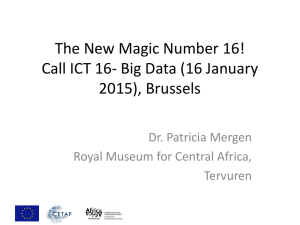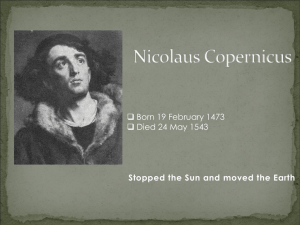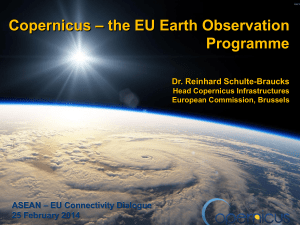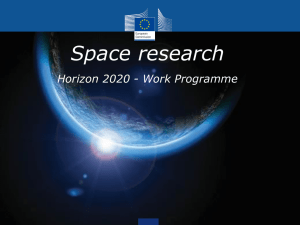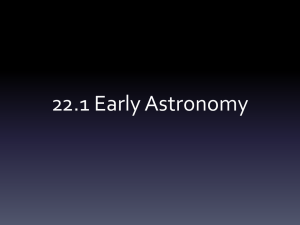Copernicus - Group on Earth Observations
advertisement
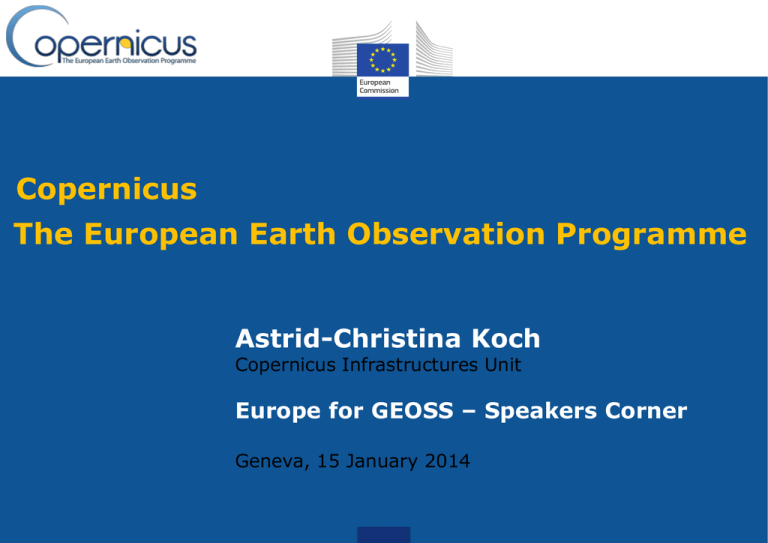
Copernicus The European Earth Observation Programme Astrid-Christina Koch Copernicus Infrastructures Unit Europe for GEOSS – Speakers Corner Geneva, 15 January 2014 Copernicus – Objectives Protect people and assets Increase general knowledge on the state of the Planet Monitor the environment Improve environmental policy effectiveness Facilitate adaptation to climate change Foster downstream applications in a number of fields Help managing emergency and security related situations Copernicus History Baveno Manifesto (first reference to Global Monitoring for Environmental Security) 1998 2001 • GMES flagship of EU Space Policy • ESA approves GMES Space Component Programme 2005 Gothenburg EU Summit (first EC involvement in establishing European capacity for monitoring the environment from space) EC proposed • Copernicus Regulation • Delegated act on Copernicus Data Policy • EC-ESA agreement on GMES signed • GMES services presented at Lille Forum 2006 EC dedicated unit (GMES Bureau) in charge of Programme development and implementation 2008 2011 Start of GMES Initial Operations (GIO) phase 2013 2014 onwards Start of Copernicus full operations phase • Launch of sentinel satellites begins • Establish six services GMES renamed "Copernicus" Copernicus Strategy • A source of information for policymakers, scientists, business and the public at large • A European response to global needs —to manage the environment, —to mitigate the effects of climate change and —to ensure civil security • A user-driven programme of services • An integrated Earth Observation system (combining space-based and in-situ data with Earth System Models, delivered to users by 6 service providers) Copernicus Space Infrastructure Sentinels Five EO missions developed specifically for Copernicus Sentinel 1 Sentinel-2 PLUS Contributing Missions Sentinel-3 Third party EO missions offering their data to Copernicus (EU/ESA MSs, EUMETSAT, commercial, international) Sentinel-4 Sentinel-5 AND High Precision Ocean Altimetry (HPOA) mission Sentinel-6 = JasonCS Six Copernicus services Services monitoring Earth systems Land Monitoring Marine Monitoring Atmosphere Monitoring Horizontal services Emergency Management Security Output: Value-Added Information Climate Change Transfer to operations As from 2014 : ESA – Space Segment (ESA + EU budget) EU Operational budget (~3.7b€ 2014-20) From 2000 to 2013: ESA – Space Segment (ESA + EU budget) EU – Development of Applications EU contribution through R&D Budget FP7 Delegation Agreements, Tenders, Service specifications R&D R & D & Innovation Horizon 2020 RD&I support for Copernicus: - Continuity in transfer (particularly in 2014) - Downstream applications & uptake - Service evolution R&D based on op. service feedback (especially post 2015) Preparatory actions GIO EU operational programme 2004 2006 2008 2010 2012 2014 2016 2018 2020 2022 9/ H2020 continuity actions for Atmosphere & Marine Service Deployment Land GIO pan-EU & local Land services GIO global land Marine MyOcean2 Atmosphere MACC-II Emergency GIO EMS Security G-NEXT G-SEXTANT Climate div. FP7 projects 2012 2013 2014 2015 2016 Adoption of Copernicus Regulation 10/ Implementation of services • In some cases, the implementation of the services may be (partly or in full) entrusted to competent EU bodies. — EEA, FRONTEX, EMSA, EUSC • For other cases, potential entities(1) are to be identified for implementation, e.g. following a call for interest — Selection criteria — Operational and financial capacity • To operate services, these service coordinating entities draw on other capable actors across Europe — e.g. via procurement from Industry value-adding companies, SMEs and possibly involving European research institutes • (1) EU Financial Regulation Article 58.1(c); "entrusted entities" for budget implementation tasks More about Copernicus services • Please come to the Copernicus side event: • Copernicus Today and Tomorrow • Thursday 16, 14:30 to 16:30 • Room 18 ( Level -1) • All Copernicus Services will be described in detail • Space Infrastructure • Copernicus data policy Copernicus Regulation • EP and Council are currently discussing the Commission proposal for a Copernicus Regulation — it should enter into force mid-2014 • Regulation describes the objectives of the programme, the governance and budget for 20142020. • Copernicus budget is EUR 3,786 million (2011 prices), pending approval of the EU 2014-2020 multiannual financial framework Copernicus Data Policy • The Copernicus data policy is adopted via a Delegated Regulation • This policy promotes the access, use and sharing of Copernicus information and data on a full, free and open basis • One of the main objectives is to support downstream segment and research, technology and innovation communities • The European research institutes will be able to make the best use of these data to create innovative applications and services Earth Observation (EO) 2014 Call Copernicus related topics (~21 M€): • EO 1 – 2014: R&D on new ideas for Earth-relevant space applications • EO 2 – 2014: Climate change-relevant space data reprocessing and calibration • EO 3 – 2014: Observation capacity mapping for Atmosphere and Climate Change monitoring • Plus continuity MACC (atmosphere) & MyOcean (marine): 11M€ Earth Observation (EO) 2015 Call Copernicus related topics (~26 M€): : • EO 1 - 2015: Bringing EO applications to the market (innovation actions) • EO 2 – 2015: Stimulating wider research use of Copernicus Sentinel data • EO 3 -2015: Imaging technologies from space Next Steps • Entry into force of Copernicus Regulation and Copernicus data policy • Implementation of services — Selection of entrusted entities — Negotiation & signature of agreements — Operational services as of 2015 • Deployment of space infrastructure — Launch of 1st satellite, Sentinel-1A, planned in 2nd quarter 2014 Potential roles of the European research institutes in Copernicus • Contribution to the provision of services • Development of innovative applications using Copernicus data and information which will be available on a free, full and open basis • Participation in H2020 calls (Earth Observation and security research), for the eligible entities Thank you for your attention Astrid-Christina.Koch@ec.europa.eu • • • Website: http://copernicus.eu Facebook: CopernicusEU Twitter: @Copernicus EU Oceans side event • GEO's Blue ocean initiative for an integrated transatlantic ocean observing system • Thursday 16 January, 17:00 to 19:0 • Room 5 & 6 ( Level 3) • Intro by DDG Strohmeier, DG Research & Innovaton • Speakers from United States, Europe, Canada Your invitation to the Copernicus event • Copernicus Today and Tomorrow • Thursday 16 January, 14:30 to 16:30 • Room 18 ( Level -1) • • • • Intro by Director Philippe Brunet, DG Enterprise All Copernicus Services will be described in detail Space Infrastructure Copernicus data policy

